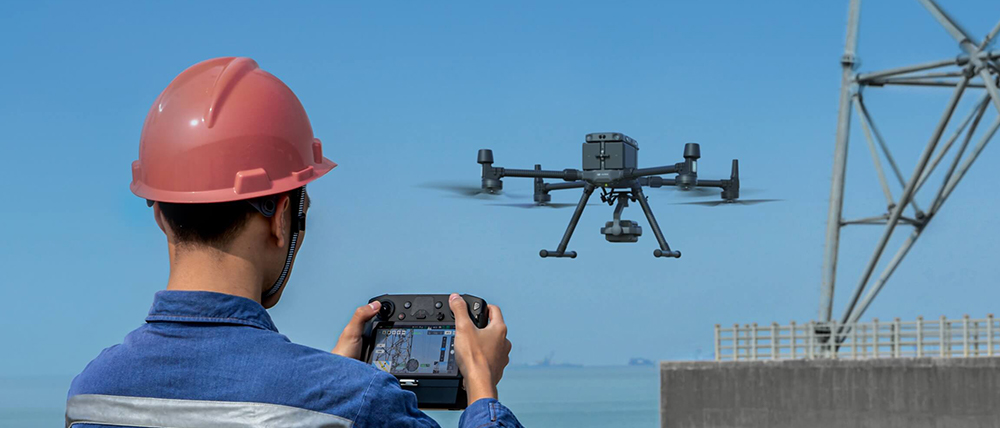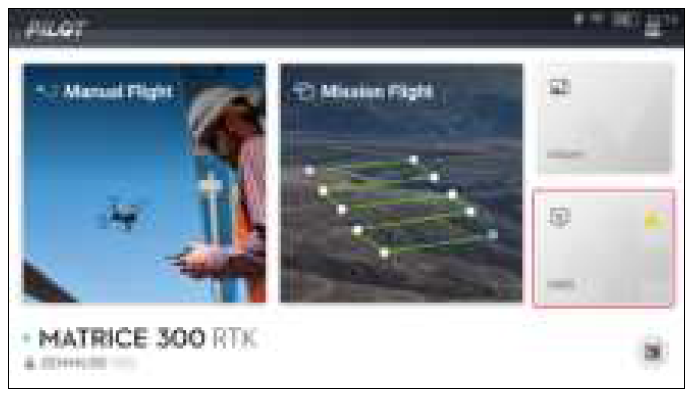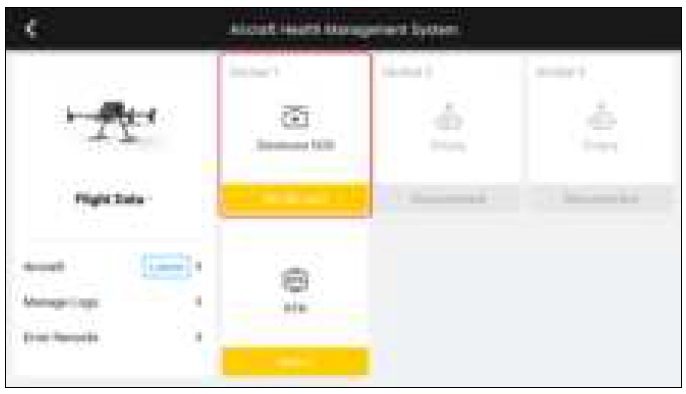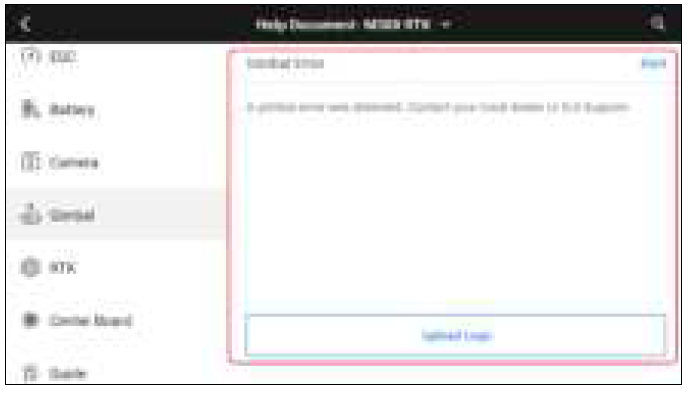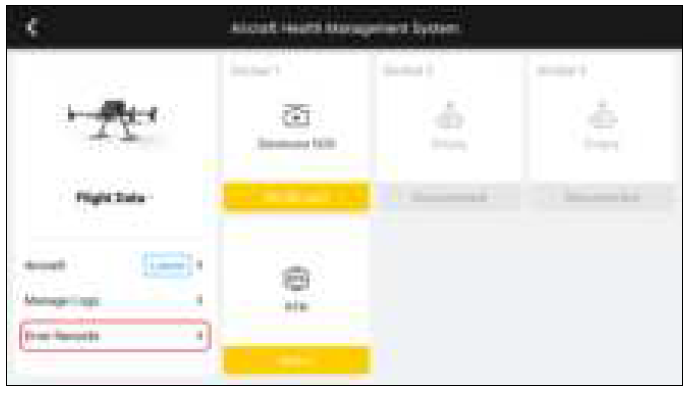MATRICE 300 RTK
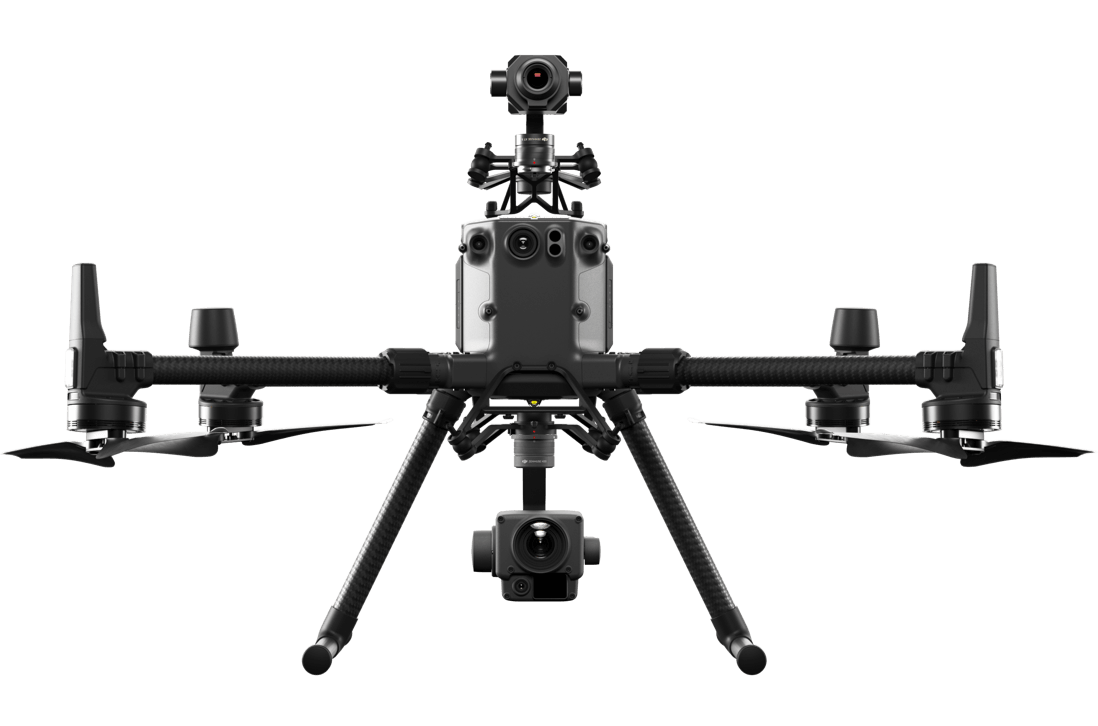
Introduction
This Maintenance Manual offers guidelines to help you in the daily upkeep and maintenance of your aircraft. A record table is also included to help you keep track of the maintenance records throughout the product lifecycle.This document will focus on the maintenance instructions and the notes, cautions, and warnings during use. Read the User Manual and Maintenance Manual carefully to optimize your user experience. If you have any questions on the maintenance operations, please contact DJI Support.
Disclaimer
Carefully read this entire document and all safe and lawful practices provided by DJITM before using this product for the first time. Failure to read and follow instructions and warnings may result in serious injury to yourself or others, damage to your DJI product, or damage to other objects in the vicinity. By using this product, you hereby signify that you have read this disclaimer carefully and that you understand and agree to abide by all terms and conditions of this document and all relevant documents of this product. You agree to use this product only for purposes that are proper. You agree that you are solely responsible for your own conduct while using this product, and for any consequences thereof. DJI accepts no liability for damage, injury, or any legal responsibility incurred directly or indirectly from the use of this product.
DJI is a trademark of SZ DJI TECHNOLOGY CO., LTD. and its affiliated companies. Names of products, brands, etc., appearing in this document are trademarks or registered trademarks of their respective owner companies. This product and document are copyrighted by DJI with all rights reserved. No part of this product or document shall be reproduced in any form without the prior written consent of or authorization from DJI.This disclaimer is available in various languages. In the event of divergence among different versions, the English version shall prevail. The final interpretation of this document and all related documents of this product belongs to DJI. This content is subject to change without prior notice. For up to date product information, visit http://www.dji.com and click on the product page for this product.
Safety Guidelines
Flight Condition Requirements
Operational RequirementsBefore use, read the Disclaimer and Safety Guidelines, User Manual, and Maintenance Manual carefully.
Flight Restrictions
- Please connect your aircraft to the internet to update the database of DJI GEO Zones regularly. Consult the relevant local government agencies or governing bodies before flight to ensure you comply with all the relevant laws and regulations.
- If flying in GEO Zones is required, apply for unlocking in advance. https://www.dji.com/flysafe
Storage and Transportation
There are safety requirements for the storage and transportation of the Intelligent Flight Batteries. Please strictly follow these Intelligent Flight Battery Safety Guidelines.
Firmware Updates
To optimize your experience, it is recommended to keep the firmware of the aircraft and remote controller up to date before each flight. Refer to the User Manual for instructions on running a firmware update.If the firmware update fails, restart the device and retry. If the problem persists, please contact DJI Support.
Inspection and Maintenance
Routine inspection before and after operations or regular maintenance can greatly improve the aircraft’s reliability, reduce potential safety hazards, and extend its service life.
Routine Inspection
It is recommended to check the following before each flight.
Checklist When Powered Off
| Type | Essentials |
|
Structure |
1. Visually inspect and use your fingers to feel the propellers, frame arms, arm junctions, and landing gears to check if they are in good condition. If there are any cracks or damage, replace the component immediately. ※
2. The screws for all the connection structures are securely tightened, especially those for the arm junctions and battery locker. 3. The waterproof rubber port covers are in place. If not, water may enter the aircraft body which will cause short circuit. 4. There is no blockage in the intake vent of the upper cooling fan. |
|
Motors |
1. The propellers are not visibly deformed, damaged, aged or softened. If they are, replace the propellers immediately. If there are any foreign objects on the propellers, clear them before use. ※
2. Rotate the motors manually to check if they are firmly installed without a gap between the motors and the motor base and the motors rotate smoothly without noise. 3. Propellers are mounted correctly. CCW propellers should be on motors 1 and 3, and CW propellers should be on motors 2 and 4. (The front-facing propeller on the right is motor 1, with motor 2, 3, and 4 arranged in a counter-clockwise order.) 4. Refer to the propulsion system section in the Regular Maintenance Items. |
|
Batteries |
1. There is no foreign object in the battery ports on the aircraft and the ports are not misshapen.
2. The battery locker is secure and will not come loose during flight. 3. The battery shell has no visible damage. If it does, DO NOT use the battery for flight. |
|
Antennas |
1. All the antennas on the aircraft and remote controller are tightened firmly and free of damage. They are in a place that will give the propellers proper clearance. |
| Gimbal (Payload) | 1. The gimbal appears intact and can rotate smoothly in all the three axes.
2. The lens is clean. |
| Radar
(Payload) |
1. There is no blockage. The shell of the radar has no damage. The mounting bracket is secure and in good condition. |
|
Remote Controller |
1. The control sticks are centered in neutral position, with no foreign object such as sand and soil, and can smoothly reach full ranges of motion in all channels.
2. The screen on the remote controller is clean and dry. |
|
Damping Plate |
1. The dampeners and gimbal anti-drop rope are not damaged. The damping plate has no crack or split. The gimbal connector is secure and cannot be rotated in the opposite direction after the gimbal is installed. |
|
Infrared Sensing and Vision Systems |
1. There is no blockage in the working range of the Infrared Sensing and Vision Systems and auxiliary lights, especially when using a non-DJI payload or accessory.
2. Check the lenses or glass of the Infrared Sensing and Vision Systems and auxiliary lights. a. Make sure there are no stickers or any other obstructions over the Infrared Sensing and Vision Systems. b. Clean the lenses and glass with a dust-free cloth if there is any moisture, fingerprint, or dirt. c. Contact DJI Support if there is any damage to the lenses of the Infrared Sensing and Vision Systems. |
|
Emergency Supplies |
1. Spare USB-C cables
2. Two pairs of spare landing gears 3. Two pairs each of spare CW and CCW propellers 4. Spare microSD cards 5. Screwdrivers, screws of all types used, cable ties, tape, a dry and soft cloth 6. A multimeter 7. A case to store emergency supplies |
It is recommended to replace the propellers only in an emergency situation during operations. After the emergency flight is over, please contact DJI technical support or an authorized agent for overhaul as soon as possible.
Checklist When Powered On
| Type | Essentials |
|
Remote Controller |
1. Confirm the control stick mode (Mode 1/2/3), and check in the control stick calibration page in the app if the proportion of the control lever is correct.
2. The remote controller has sufficient power and the battery is firmly installed. 3. Confirm that the channel used is automatic or custom, and then choose the operation frequency and channel according to the signal to noise ratio. |
|
Battery |
1. All batteries, including Intelligent Flight Batteries and remote controller batteries, are fully charged.
2. It is recommended to charge and discharge the battery by following the standard instructions before flight if the battery is stored for a period longer than one month. 3. The Intelligent Flight Batteries are firmly installed. 4. Check the battery level and voltage of each battery cell in the battery page in the app to make sure they are normal. |
|
Flight Parameters Configuration |
1. The Failsafe action of the aircraft is what fits your mission needs. For example, the aircraft will land as a failsafe within in 50 m of the Home Point, and it will hover as a failsafe when it is within in 200 m from the Home Point.
2. The flight mode switch is set up correctly. 3. RTH altitude, height limits, distance limits, and obstacle sensing function are set up correctly. |
| Module Auto- Check | 1. View the module auto-check information on top of the screen in the app to check if there is any error prompt. |
|
GNSS Positioning |
1. There are at least 7 satellites and the aircraft works in P-mode.
2. Enable RTK function, select the correct base station and channel, and make sure that RTK positioning is in use. Check in the RTK page if the heading and positioning are fixed. |
| Sensors | 1. Data on each IMU is shown in the app. IMU calibration can be performed successfully.
2. Data on each compass is shown in the app. The heading of the compass matches the physical one, and the needle is stable. 3. Compass calibration can be performed successfully. 4. The Vision System in all directions are enabled and there is no error prompt. |
| Top and Bottom Cooling Fans | 1. Touch the shell of the cooling fans or listen carefully to check if the cooling fans
work normally without noise. |
|
Firmware Consistency |
1. Connect the remote controller to the internet, then launch the app. Make sure that the app and the firmware versions of the aircraft, remote controller, payloads, and batteries match. Otherwise, the aircraft cannot take off or there may be risks.
2. Insert all Intelligent Flight Batteries into the aircraft to make sure that all of their firmware versions are up to date. |
|
Motor Spin |
Link the remote controller and aircraft, make sure the FPV camera display in the app works normally, and then perform Combination Stick Command (CSC) to start the motors in a safe indoor area to make the motors spin at an idle speed. Then test the following. NOTE: Stay away from the spinning motors and propellers to avoid injuries during the test.
1. The motors start without noise. There is no error prompt in the app. 2. At the beginning when the motors start or the end when the motors stop, observe the motors to make sure that motors 1 and 3 rotate counter-clockwise while motors 2 and 4 rotate clockwise. |
Flight Test Checklist
| Type | Essentials |
| Flight Test | 1. Make sure that there are no potential safety hazards or people within 5 m of the
aircraft. 2. Make sure that the satellite count is more than 10 and there is sufficient light. Start video recording. 3. In P-mode, perform CSC to make the motors spin at an idle speed on the ground. Push the control sticks in each direction lightly to test. Then push the throttle stick down to the bottom until the motors stop. 4. In P-mode, perform CSC to make the motors spin at an idle speed on the ground. Observe to check if the aircraft shakes. Then push the throttle stick down to the bottom until the motors stop. 5. In P-mode, take off and then hover at a height of 5 m for 1 min. Check to see the aircraft horizontal drift is no more than 1 m and the height drift is no more than 0.5 m. Check the shake of the aircraft, battery status, sound of the motors and propellers. 6. Push the control sticks in each direction lightly to check if the aircraft responds correctly. 7. Gradually increase the movement of the control sticks to observe the attitude response and the shake of the aircraft when braking. 8. Set height limits and distance limits. Then test if the aircraft can obey the limits. 9. In P-mode, enable obstacle sensing. Then test if the aircraft can avoid obstacles in left, right, front, rear, and upward directions. 10. In P-mode, fly the aircraft more than 20 m away from the Home Point at an altitude less than the preset RTH altitude. Initial RTH using the RTH button on the remote controller to test if the aircraft can perform ascending, cruising, landing in order and the landing position has an error no more than 1 m from the Home Point. 11. Stop video recording after landing. |
|
Checklist after Landing |
1. The propellers, motors, and aircraft body are intact, and there is no sign for
collision or loose or broken structures. 2. The temperature of the motors is normal, no signs of uneven heating. |
Regular Maintenance
It is recommended to perform inspection and maintenance regularly by following the standards below to keep the aircraft in a good condition and reduce safety risks.
Maintenance Standard
| Type | Maintenance Items | Maintenance
Advice |
Period |
| Basic
Maintenance |
1. Regular maintenance items
2. Updates and calibration 3. Deep cleaning |
Factory service
recommended |
Total flight time is 200 hours, or the product has been used for 6
months. |
|
Routine Maintenance |
1. Regular maintenance items
2. Updates and calibration 3. Deep cleaning 4. Components replacement due to wear and tear |
Factory service mandatory |
Total flight time is 400 hours, or the product has been used for 12 months. |
|
Deep Maintenance |
1. Regular maintenance items
2. Update and calibration 3. Deep cleaning 4. Component replacement due to wear and tear 5. Core component replacement |
Factory service mandatory |
Total flight time is 600 hours, or the product has been used for 18 months. |
Regular Maintenance Items
Propulsion System
| Type | Inspection Process and Solutions | Illustrations |
|
Motor Rotation |
1. Unfold and secure the frame arms. 2. Rotate the rotor of the motor to check if there is any blockage or rubbing. Observe the gap between the rotor and stator of the motor to check if there is any rubbing with the motor base. 3. DO NOT fly the aircraft if there is any blockage or rubbing mentioned above. It is necessary to return to the factory for repair. |
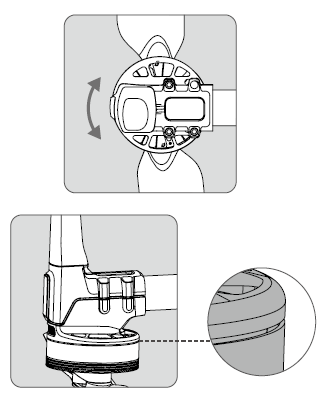
|
|
Connection between Motor and Arm |
1. Rotate the motor base around the central line of carbon tube to check if the motor and carbon tube connection is loose.
2. The four fixing screws are secure. 3. If any screw is loose, return to the factory for repair. |
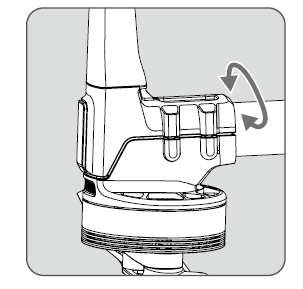 |
|
Motor Upper Cover |
1. The screws on the upper cover are not loose. There is no damage or crack on the upper cover.
2. If screws are loose, apply thread locker and tighten the screws. 3. If the upper cover is damaged or cracked, return to the factory for repair. |
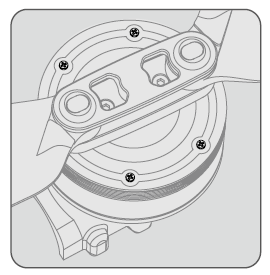 |
|
Motor Air Filters |
1. Air filters are not loose or damaged. 2. If they are loose or damaged, return to the factory for repair. |
 |
| Propellers | 1. Check the propellers for visible deformation, severe wear, nicks, and cracks, and if there are any foreign materials.
2. Clean the propellers with a dry soft cloth. 3. Replace the propellers immediately if visible deformation, severe wear, nicks, or cracks occur. ※ 4. Replace the propellers after flying over 300 hours or using for one year. ※ |
|
| Propeller Adapters | 1. The propeller adapter screws are secure.
2. If the screws are loose, apply thread locker and tighten the screws. 3. The propeller adapters are not misshapen or broken. 4. Replace the propeller adapters if they are misshapen or damaged. |
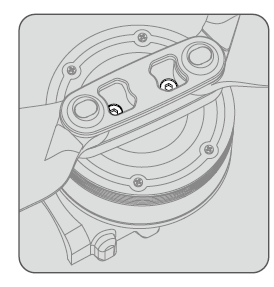 |
It is recommended to replace the propellers only in an emergency situation during operations. After the emergency flight is over, please contact DJI technical support or an authorized agent for overhaul as soon as possible.
Flight Controller
- After the aircraft is powered on and self-check is complete, there are no error prompts in the app related to the flight controller.
- In outdoor open environments, GPS signal has four bars within 1 min after powering on the aircraft, which indicates that the Home Point can be recorded automatically, and the RTK data meets the heading measurement standard.
- In outdoor open environments, the interference of the compass after calibration is less than 50.
- Sensor bias is less than 0.05 after IMU calibration.
Battery
Battery Maintenance Conditions
Maintenance is required when any of the events below occur.
- Every 50 cycles
- The battery is idle for more than three months
- There is a maintenance prompt in the apps
Checklist for Maintenance
- Charge and discharge the battery as per instruction
- Make sure the cell voltage difference is less than 1 V after the battery is fully charged and left stationary for six hours.
- Make sure the battery is not swollen, leaky, or damaged
- Make sure battery terminals are clean
- Make sure the battery firmware is updated to the latest version
Health Management System
Users can view the status of each module and upload the log with abnormal status in the Health
Management System (HMS) page in the DJI Pilot app.
- Enter the HMS page in DJI Pilot.

- The health condition of each module of the connected device will be displayed onscreen.

- If any module is abnormal, tap to view the warning message.

- Tap the warning message to view the help document for troubleshooting. If the abnormal status still exists after check by following the document, users can upload the log and contact DJI Support for help.

- View the error records and check if there are frequent error prompts or critical warnings. If the problem cannot be solved, contact DJI Support

Appendix
Maintenance Record
| Date | Maintenance Items | |
|
Total Flight
Time |
(hours) |
□ Propulsion System □ HMS
□ Flight Controller □ Vision System Calibration □ Aircraft Body Structure □ Firmware Update □ Batteries □ Core Components Replacement □ Component Replacement Due To Wear and Tear |
|
Maintainer Signature |
||
|
Maintenance Date |
Maintenance Items |
|
|
Total Flight Time |
(hours) |
□ Propulsion System □ HMS
□ Flight Controller □ Vision System Calibration □ Aircraft Body Structure □ Firmware Update □ Batteries □ Core Components Replacement □ Component Replacement Due To Wear and Tear |
|
Maintainer Signature |
||
|
Maintenance Date |
Maintenance Items |
|
|
Total Flight Time |
(hours) |
□ Propulsion System □ HMS
□ Flight Controller □ Vision System Calibration □ Aircraft Body Structure □ Firmware Update □ Batteries □ Core Components Replacement □ Component Replacement Due To Wear and Tear |
|
Maintenance
Date |
Maintenance Items |
|
|
Total Flight
Time |
(hours) |
□ Propulsion System □ HMS
□ Flight Controller □ Vision System Calibration □ Aircraft Body Structure □ Firmware Update □ Batteries □ Core Components Replacement □ Component Replacement Due To Wear and Tear |
|
Maintainer Signature |
||
|
Maintenance Date |
Maintenance Items |
|
|
Total Flight Time |
(hours) |
□ Propulsion System □ HMS
□ Flight Controller □ Vision System Calibration □ Aircraft Body Structure □ Firmware Update □ Batteries □ Core Components Replacement □ Component Replacement Due To Wear and Tear |
|
Maintainer Signature |
||
|
Maintenance Date |
Maintenance Items |
|
|
Total Flight Time |
(hours) |
□ Propulsion System □ HMS
□ Flight Controller □ Vision System Calibration □ Aircraft Body Structure □ Firmware Update □ Batteries □ Core Components Replacement □ Component Replacement Due To Wear and Tear |

References
[xyz-ips snippet=”download-snippet”]

